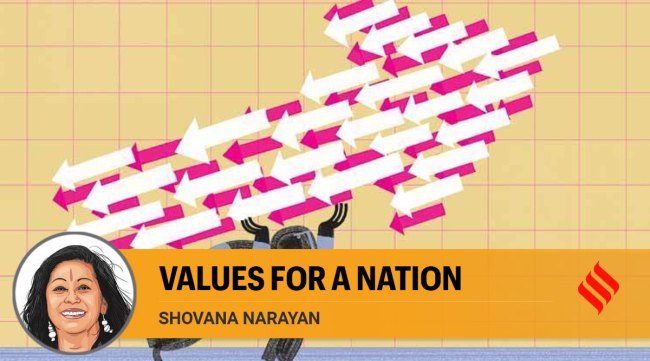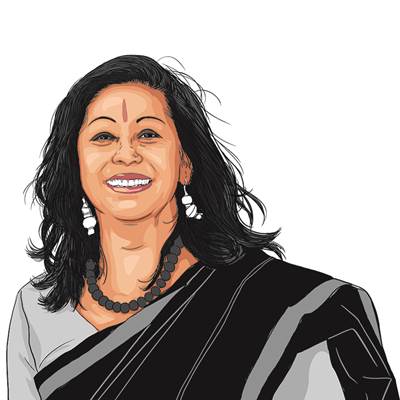Opinion India@75, Looking at 100 | Shovana Narayan writes: Responsibility of shaping society lies with each of us
My India at 100 should be a beacon of change, where every individual has a reasoning mind and does not lose sight of sensitivity and concern while utilising all the freedoms, powers and rights guaranteed to a citizen.
 My India at 100 should be a beacon of change, writes Shovana Narayan.
My India at 100 should be a beacon of change, writes Shovana Narayan.
I was born a few years after Independence and saw the dedication of people engaged in nation-building. From a country where poverty and illiteracy abounded, we have come a long way. From contributing just three per cent of the world GDP, India has become the fifth-largest economy in the world.
Soon after Independence, the potent soft power of the country and the need to preserve, propagate and nourish various art forms, dance, theatre, literature, ancient practices such as Ayurveda etc. was recognised.
Much was done in pursuance of a cultural and national identity to create strong institutions, such as the three Akademis, various cultural centres, Ayurveda and yoga centres. Their benefits are visible all round, as our artists, scientists and engineers are today recognised across the world.
Most evident are the changes in the dignity and status of women. Today, the rigidity of gender and caste barriers have broken down considerably and women have ventured to domains once denied to them. Yet, the question that needs to be asked is how independent we are today.
Political freedom, economic, agricultural and scientific growth, technological and infrastructure development are important aspects; but so is human development. Human emotions never change. What is of importance is how we harness these emotions to enable people to contribute to society positively.
So what is the India, the Bharat, that I would like to see when it turns 100?
As a classical dancer, it is but natural for me to turn to our myths and ancient Sanskrit texts to seek answers. It is often said that there is no situation or emotion that cannot be found in the Mahabharata. Every episode in this epic holds relevance even today, teaching us the art of living, if only we care to learn from them.
History and mythology have repeatedly alerted human beings to the values and ideas that they need to attend to. These include: One, curbing the natural tendency to seek revenge, which, if unchecked, could lead to a situation like that of the Mahabharata war, which ended in death and misery. Two, keeping a check on the lust for power, which has proved fatal for many. Three, recognising that half knowledge can be dangerous, as seen in the case of Abhimanyu. Four, facing obstacles and challenges with courage and determination, without hatred, anger and revenge. An example is Eklavya, who was rejected by Dronacharya. Five, recognising that even empowered women could be vulnerable. Draupadi was an empowered, emancipated woman in many ways, yet she became a pawn in a fateful game of dice. Today, too, there are millions of girls who are being used as pawns, millions of Draupadis who are abused, whose dignity continues to be played with.
Similarly, discussions on environment and equality are meaningless if they are not practised. We need to address development of the inner self, emptying ourselves of negativities, desires, hatred, ill-will and greed. The responsibility and accountability of making and shaping a society and therefore, a nation, lies with each of us. Whatever rank we may have in the eyes of the world, we should be concerned with the development of core human values, including respect for fellow humans, irrespective of caste, sect, gender, religion, ideologies. We should build a nation where dignity is ensured.
At 100, I would like India to have addressed the issue of “poverty” in its larger dimension, as seen in the following verse:
Poverty of mind, poverty of deed/ Poverty of soul, poverty to lead,/ Poverty of noble thought, poverty of dignity,/ Poverty of virtues, poverty of humanity,/ Poverty of understanding and of kindred spirit,/ Poverty of responsibility and of respect./ All the world’s wealth is meaningless before poverty of life/ All the world is rich, if there is richness of mind
My India at 100 should be a beacon of change, where every individual has a reasoning mind with scientific temperament and does not lose sight of sensitivity and concern while utilising all the freedoms, powers and rights guaranteed to him/her as a citizen. Ultimately, it is people who make a nation.
The writer is a Kathak guru, performer and choreographer, IA&AS (retd) and author. This article is part of an ongoing series, which began on August 15, by women who have made a mark, across sectors



